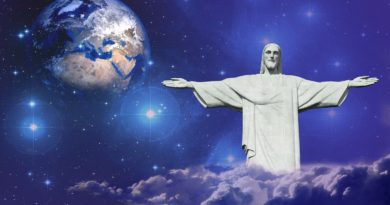Rebooting the Bible
The astonishing story of a 1900-year-old conspiracy to corrupt biblical history and thwart belief in Jesus as the Messiah.
By S. Douglas Woodward
It is the Western World’s most celebrated book, published in two volumes – the Old and New Testaments. Thanks to the beautiful language employed, it established the English language more profoundly than the writing of Shakespeare. No book has impacted the world more. No published manuscript has sold better. And yet, few think it free from flaws. It remains a thoroughly human book.
It was based upon The Bishop’s Bible of 1569. A 47 scholars, all members of the Church of England, worked collectively to create it. These scholars referenced other Bibles created by Martin Luther, William Tyndale, and Ronald Knox. When finished, it entered the public domain in 1611. Earlier Bibles in the Church of England were slowly phased out throughout the seventeenth century.
Its New Testament used the Textus Receptus (TR) as its Greek source text. The TR was initially translated by Erasmus in 1516. The TR would be revised by Karl Lachmann in 1831, Trelles several times from 1857 to 1879, and Constantin von Tischendorf who would edit eight different versions. Revisions were necessary not because of poor grammar, but due to better rendering of the Greek as determined through additional manuscripts that came to light as the years advanced.
Its Old Testament considered Jerome’s Vulgate (ca. 400 A.D.) disseminated in the fifth century by the Western (Roman Catholic) Church. And to a lesser extent, it referenced the Septuagint, a Greek translation of the Hebrew Old Testament translated by 70 scholars in Alexandria, Egypt, beginning 300 years before the crucifixion of Christ.
This Septuagint (abbreviated LXX, the Roman numerals for seventy), remains the Bible of the Orthodox Church to this day. Besides the Bishop’s Bible, The Geneva Bible and Tyndale Bible would also contribute to its marginal notes, many which included alternate readings and factors adding to the variations of meaning the translators wanted the reader to consider. The scholars who completed the translation understood that any adaptation to another language introduces possible misunderstandings from what the original author intended when first written. Based upon their preface to this book, they believed others would come later and revise the translation to make it more fitting for future ears.
When it was completed, like the Septuagint and Vulgate, it contained supplemental texts to the more well-known and widely accepted biblical books. We call this collection, the Apocrypha. A century or so later, the Apocrypha would be dropped from its published version. The Hebrew Bible did not include it, and Protestant Reformers chose the Hebrew Bible to become its standard. Afterward, to evangelize the world, Protestant scholars would begin creating translations for almost all languages.
It was revised many times. Those revisions were performed by additional scholars beyond the original 47. These revisions were completed in 1629, 1638, 1762, and 1769. The most popular edition from 1769 was produced by Dr. Benjamin Blayney. Today’s published versions of this revered Bible are primarily based on Blayney’s revision.
Of course, I am talking about the King James Bible.
The King James Bible
King James’ name was not originally connected to this Bible. It was an “authorized version” just as The Great Bible and The Bishop’s Bible had been authorized by Henry the VIII and his daughter, Queen Elizabeth I respectively, during the previous century. Dropping his name might have been appropriate since King James led a life of debauchery and was a known bisexual. He hardly deserved such a distinguished namesake.
For some, the mandatory usage of The King James Bible is a hedge against secularism and apostasy. In our world today, many conservative churches continue to argue vehemently that the KJV is the only trustworthy source, for it is the only Bible deemed to have the “imprimatur” of the Lord. They feel God not only supernaturally inspired the original autographs of the biblical writers, but he also supernaturally inspired its preservation. As one advocate told this author, “Without God’s inspired preservation, the inspiration of the autographs is meaningless.”
For conservative Evangelicals, there can be no compromise. (I hesitantly label these brothers and sisters Fundamentalists to contrast but not to disparage.) These brethren believe The King James Version and only this version constitutes the Word of God. All other versions contain errors and fall short.This judgment is not based on literary quality. It is judged that this Bible is the only writ that the Lord in Heaven supports. Those who advocate a different English Bible are often considered reprobates and apostates. Since God inspired the KJV – and only the KJV – true Christians must accept its full inspiration unflinchingly.
Young Earth

Closely tied to the commitment to the King James Bible, is the advocacy of a belief in “the Young Earth” – a view that the world was created just a bit over 6,000 years ago. The Bible does provide a chronology within its genealogies in Genesis chapters 5 and 11. And this chronology was supported by the research of Bishop James Ussher, not long after publishers released the KJV to the public. This traditional conservative position demands that the universe (including humanity) was created in six, twenty-four-hour days, precisely six millennia ago. It took place on the first Rosh Hashanah, in 4004 B.C., when God created all that is. To believe otherwise – that the world is billions of years older than this – is to trust in secularism and evolutionary science, while denying the Word of God is literally true. Until little more than a century ago in America, most Evangelicals believed this. Science became our enemy.
It is often argued as a justification for this restrictive view that the people of God must have an absolute and unchanging Word from God – and that Word must be without the human capacity for error. In other words, for the people of God to be wholly equipped as His Saints, the Scripture must be accurate, in whole and in part, as well as free from any taint of obscurity.
Undoubtedly, the preservation of God’s Holy Word involves conceptual complexities. Since it was written by human authors and has been passed down by human means, God’s Word must be seen to be a human enterprise. And yet, just as Christ Jesus was both human and divine, the Word of God in Scripture also provides God’s revelation to us. So, since all Evangelicals agree that the Bible is the Word of God, how can we articulate the method by which God preserves His Word through time? There are, indeed, numerous issues to address when attempting to arrive at a satisfactory resolution to the Bible’s dual nature – that is, its human and godly character. But at this juncture, allow me to provide what may seem to be an overly simplistic explanation of the two competing perspectives that conservative Christians hold concerning the preservation of the Word of God in the Bible:
1. Alternative one: The Spirit of God preserves the Word of God presented through the Bible by inspiring only one specific version which believers must declare is God’s Word. This text was published at one particular time in one particular language with no changes allowed whatsoever. And it has been decided by some that God preserves His Word in English through the KJV. Tradition mandates this version is the only acceptable, inspired translation.
2. Alternative two: The Spirit of God providentially preserves the Word of God presented through the Bible from the work of scholars who study the text, applying reason and science to detect the authentic, original words and meaning as intended by the author. If God preserves His Word in this manner, human agents (i.e., scholars), must demonstrate evidentially which text or meaning is most authentic to what was first written millennia ago.
The methodology of alternative one is this: Corrections to spelling or grammar must be rejected, archaic language must be accepted and not modernized. Newly discovered manuscripts that might identify the original wording should be ignored. Hence, discoveries like the Dead Sea Scrolls are to be dismissed. A new codex, likeCodex Sinaiticus (dated to the fourth century A.D.), is disregarded. Thus, defending the Bible means blocking all attempts to alter it while overturning all claims to flaws in its contents, whether it’s spelling, grammar, historical accuracy, or scientific knowledge. Finally, newer versions are banned since they alter the words of the accepted version. The Bible should be “frozen” as is, in the version tradition demands.
The methodology of alternative two is this: Scholars detect, through reason and investigation, which wording (i.e., “reading”) is most likely to be authentic to the original work. Newly discovered manuscripts provide new insights into the wording of the original. Publishers may employ scholars to research and translate the Hebrew, Aramaic, and Greek texts that clarify the language of the Bible conveying a meaning of God’s Word that is able to communicate effectively to us today. A good example: Erasmus used seven manuscripts in creating the TR. A modern Bible utilizes approximately 5,900 manuscripts. Many linguistic tools exist to help the textual critic determine with high probability, the authentic language of the author. And newly preferred words clarify its meaning for modern readers. Such texts point out spurious additions or changes through time. Therefore, we can conclude, “The more manuscripts, the better. We are better able to discern the original.”
However, before we sally forth to prove the thesis of this book, the reader should acknowledge God’s Word shines best through the purest glass possible. If we close our mind to any effort to purify the medium in which God has revealed Himself, namely the Bible, then my campaign is defeated at the outset.
The Masoretic Text Corruption

This is so because the argument this book puts forth is that the King James Version was created using the Masoretic Text (MT), and therefore, was corrupted long before today. It happened nineteen centuries ago. This corruption was intentional. It was carried out by those rabbis who survived the destruction of Herod’s Temple. Roman authorities granted them permission to create an academy in the town of Jamnia (Javneh), on the coast near Tel Aviv.
There, changes were made to the original Old Testament, that focused on two areas: First, the Messianic passages of the Old Testament; and secondly, two chronologies in Genesis, chapters 5 and 11. As this book will lay out carefully, the rabbis, headed by Rabbi Akiba ben Yosef, sought to recreate Judaism while at the same time quashing the rival cult known as Christianity. Rabbinic authorities decided to obscure specific passages that supported Christian evangelists who preached Jesus of Nazareth was the promised Messiah.
At Jamnia, these rabbis created an alternate Vorlage, or original scripture, from which a new Greek translation would be created that contradicted the Greek Septuagint, hoping to replace this Greek Bible used by Christian apostles and teachers, especially for the Jewish communities globally. After three centuries had elapsed, and with some help from the Christian patrons Origen and later Jerome, the rabbis ultimately succeeded, at least to a meaningful extent. This would lead to one Latin and three new Greek versions based upon this Vorlage. The “revised” Vorlage differed from the original Bible, compiled (so tradition tells us) by Ezra and then safeguarded by Nehemiah and the other courageous Jews that returned from the Babylonian Empire in the fifth century B.C. (circa 445 B.C.). This new rabbinic (corrupted) Hebrew Vorlage was created about 100 A.D., while the later Greek versions were originated before the end of the second century A.D., and the Latin Vulgate, approximately 400 A.D. The Septuagint’s Pentateuch was finished 380 years before the rabbinic Vorlage and 680 years before the Vulgate.
Messiah Prophecies and 1,500 Missing Years

You see, the Septuagint had been translated in Alexandria, Egypt, from the authentic Hebrew Vorlage brought from Jerusalem for the translation. Why did the Hebrew Vorlage differ? For the rabbis, the prophecies concerning the Messiah as translated in the Septuagint easily applied to Jesus. They rejected Jesus was the Messiah.
Nevertheless, Christians believed it was obvious that Jesus had fulfilled the prophecies of Moses, David, Isaiah, and the other ancient prophets. Additionally, because the tradition of the Jews held that the Messiah would arrive near the time Jesus appeared on the scene, the timing of the Messiah’s arrival had to be altered so that Jesus would not be identified as the Christ.
Thus, over one thousand five hundred years (1,500) were cut out of the original Genesis genealogies/chronologies. And another 130 years or so were deleted by the rabbis in the timing laid out in Daniel’s prophecy of the 70 “weeks” of years. Their efforts amount to a conspiracy to disqualify Jesus as the Christ. To accomplish this, Rabbi Akiva and his disciples at Jamnia obscured the Messianic prophecies and the chronology of Genesis from Adam to Abraham.
Given the New Testament authors used the Septuagint 90 percent of the time when quoting the Old Testament, perhaps ironically, Christianity preserved the meaning of the original Hebrew in these specific passages (and quite a few others as we will show).
Getting back to whether the King James Bible stands as the sole trustworthy version of the Bible, this book (Rebooting the Bible: Exposing the Second Century Conspiracy to Corrupt the Scripture and Alter Biblical Chronology) will demonstrate that the MT was more than tampered with about 1,511 years before the KJV was completed in 1611. And since the KJV Old Testament is based on the MT, it is incoherent to hold the view the KJV was flawlessly inspired by God. Once demonstrated that the razor-sharp prophecies of Messiah were surreptitiously dulled in the “revised” Hebrew Vorlage at Jamnia, to argue the KJV remains free from taint becomes more than moot. This is so because the variances introduced go to the heart of Christianity’s claim that Jesus is the Christ.
A second important point is this: If Evangelicals wish to select the Bible that most closely conveys the original work of its Hebrew authors, it is the Greek Septuagint and not the Hebrew or Latin versions that we should adopt as our primary text. This is despite the fact that all Protestant Bibles (and most of the Latin Vulgate) began with what would become known as the altered rabbinic Masoretic Text.
This doesn’t mean that the Septuagint has no blemishes nor does it mean that the Hebrew should be abandoned. Not at all. Only specific passages differ between these other versions. But they are concentrated in two critical places: Messianic prophecy and ancient biblical chron-ology. If Protestants should seek the authentic Word of God, it requires we lay claim again to the Greek Bible of the early Church, its exclusive Bible for over 500 years before the Vulgate slowly began to replace it in the Western Church. Once we do,we possess the authentic biblical witness to the year of Creation as set forth in Genesis, the date of the Great Flood, the birth of Abraham, and, with the analysis this author provides in the pages that follow, the year of the Exodus and the Conquest of Canaan. This book will break the code on how the Septuagint unlocks these mysteries and offers a complete chronology reaching from Jesus Christ to Adam.
Unlocking the Genesis Code
While academics can (and should) debate the original wording of the Septuagint, research shows that academics almost never assume any ulterior motives influenced the changes made in the proto-Masoretic as this author asserts. My point in response: One cannot determine the original wording of the passages in question, without suspecting that there was a rabbinic conspiracy to alter the text as this book contends.
It is not my intention to weaken the faith of conservative Christians. Instead, I wish to strengthen it by showing beyond a reasonable doubt that the Bible offers clarity on who the Messiah is and when he would come offering the Kingdom of God to the Jews. And please note, this book does not criticize the KJV New Testamentsince its citations of the Old are almost always drawn from the Septuagint and not the Hebrew.
This book will argue forcefully that the rabbis at the end of the first century A.D., and on into the second, were deliberate in their attempt to weaken the Christian message of salvation by faith in Jesus Christ, favoring instead the newly scribed Oral Tradition (a huge addition to the original Mosaic law). This Oral Law remains subject to criticism being that it is without biblical support. No such law existed dating from the time of Moses. Where this “oral law” appears referenced in the New Testament, Jesus condemns it, calling it only the “tradition of men,” specifically of the Pharisees (who would become the rabbis of the second century). But that debate constitutes a separate matter for a different study.
I will no doubt be accused of anti-Semitism for scorning the foundation of what I believe is a new Judaism, differing from the Old Testament Temple religion. However, this book is not an anti-Semitic diatribe. Like many evangelicals, I wish only the very best for the land of Israel and Jews everywhere. Indeed, if there is any superior race, history testifies that it is the Jewish race, given its seemingly indomitable culture, brilliant minds, and contributions to the world in so many fields. As one influenced by dispensationalism during my early years of research, I still argue that Yahweh continues His plan for the Jews which includes the nation of Israel today.
The scope of my critique is limited to what happened in the second century. My “indictment” addresses to one specific aspect of the original objectives of the Jamnia Academy. That targeted challenge is to the clandestine goal of Rabbi Akiba. In other words, the problem this author has is not so much that Judaism was reinvented by the rabbis. Instead, it is that this school altered the Bible to confuse other Jews and lead them away from their true Messiah. Except for Jewish converts to Christianity, the Jewish people missed the day of God’s visitation. I hope that by identifying the rabbinic conspiracy alleged in this book, it will reopen for many Jews the question whether Jesus was indeed their promised Messiah, by highlighting the many Old Testament prophecies that speak to the historical identity of the Messiah – Jesus of Nazareth. This offering is presented to all Jews, so that they may see for themselves that Yahweh kept His promise two thousand years ago by granting them a deliverer and redeemer. Our Redeemer liveth (Job 19:25).
Archeology Supports the Septuagint’s Timeline

Finally, there is another bonus I offer which will be taken up mostly in Part 2 of Rebooting the Bible. Once we ascertain the correct dates of the events in Genesis, we discover the findings of Archeology are reconcilable with the Bible.
The added 1,500 years included in the Septuagint’s timeline (and confirmed by other ancient witnesses we will identify), suddenly line up the Bible’s chronology with the findings of Egyptology and Mesopotamian Archeology. The foundation for this reconciliation is laid here in Part 1. But it remains a vast subject unto itself and requires a second volume to come near summertime of 2019. This sequel will also include an examination of the many extra-biblical works that Christians have been introduced to and enthusiastically embraced over the past decade. And it also will consider the claims of alternate history that might span beyond the date the Bible proclaimed when Adam and Eve were created and lived in Eden.
So, to be clear, this first book is part of a two-book project. To recap, Part 1 examines why and how the conspiracy of Jamnia altered the biblical text, how it eventually led to a fateful mistaken choice made by Protestants, and how it obscured the actual time when the most vital events in Genesis took place.
To achieve this objective, this book concludes with a necessary and thorough analysis of (1) the Exodus and (2) the outset of the Conquest of Canaan since their respective dates are the gateway to the earlier Genesis chronologies. Abraham is the bridge between primeval biblical history (in the first eleven chapters of Genesis) and the biblical account that comprised the rest of the Bible. I am hopeful Part 2 will be available within 9 months of this volume. A draft of the outline for Part 2 is provided as Appendix 6 in the back of this book.
May God bless those who read and prayerfully consider these words.
S. Douglas Woodward, Th.M., MA in Finance (to be completed, May 2019), is 64. He grew up in Oklahoma City, where he lives once again, after working in Boston for six years and Seattle for 21. Doug’s experience lies primarily in business information technology and financial management where he has served as an executive for Oracle, Microsoft, and a Partner at Ernst & Young LLP. He also founded his own consultancy for young companies, Smart Starters, which he managed for 10 years, before becoming Entrepreneur-in-Residence at the University of Oklahoma, Price School of Business, where he has taught classes in entrepreneurship for five years. Over the past seven years, Doug has become a nationally recognized author having written fourteen books on the topics of America’s spiritual history, eschatology, theology, and geopolitics. His books of note include The Final Babylon, Decoding Doomsday, Power Quest (Books One and Two), Lying Wonders of the Red Planet, The Revealing, The Next Great War in the Middle East, and Revising Reality. Rebooting the Bible is number fifteen. He frequently appears on radio and television programs having been interviewed on over 100 different occasions on several dozen different shows. Additionally, he speaks at conferences concerning the multiplicity of topics about which he writes. Doug has two amazing adult children, an incredible daughter-in-law, two fabulous grandsons, and a beautiful wife, Donna, with whom he celebrates over 43 years of marriage. Discover more at www.Facebook.com/sdouglaswoodward and www.faith-happens.com.





